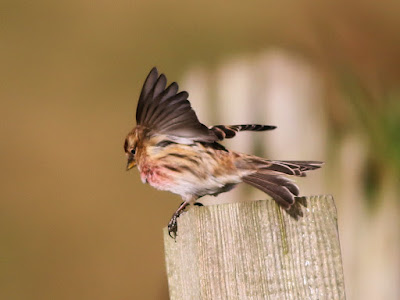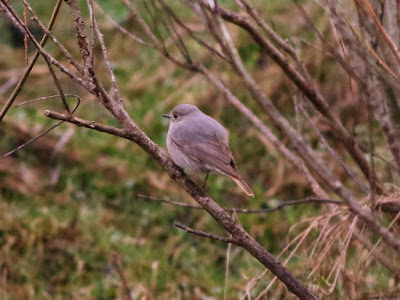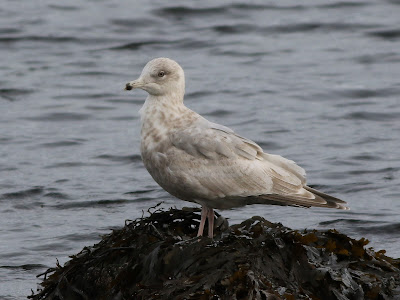A ringtail Hen Harrier was hunting over moorland just north of Burravoe, Yell where I saw Golden Plovers engaged in flight display for the first time this year and an overflying Snow Bunting. A drive along the foreshore at Uyeasound produced better views of the Kumlien's/Thayer's Gull under heavily-overcast skies. Needless to say this intriguing Gull always looks at its darkest under overcast skies and today's views and the images below were obtained shortly before it was raining. Now, armed with Amar Ayyash's latest appreciation of the 'Iceland Gull' complex in his North America Gull Guide (2024), it's interesting to revisit its subspecific identification and again ponder were the arbitrary lines are drawn in a continuum! It was seen alone today, but on a previous occasion, it has been seen to be the same size as the smallest accompanying Herring Gulls.

Ayyash (2024) describes the 'eyes are typically dark at this age' for 2nd cycle Thayer's Gull albeit states that 'some show a paling, honey-coloured iris'. The Uyeasound Gull's bill pattern and its overall plumage including its greater coverts, tertials and pale-fringed primaries appear a close match to Thayer's Gull Plate 32A.17 described as 'an icy [2nd cycle] individual'. For second-cycle Thayer's Gull, Ayyash (2024) describes 'the greater coverts are typically uniformly patterned', 'the tertials are dark-centred, typically darker than the wing coverts, with some greyish-brown stippling sometimes found near the feather tips and edges', 'the primaries are decidedly brown, with many individuals showing pale edging, boldest around the feather tips' and even that a 'postocular line is detected at times', all of which, arguably, could equally apply to the Uyeasound Gull.

A feature detailed by Ayyash (2024) of second-cycle Thayer's Gull are the entirely dark outer webs on the outer primaries (typically from p5/6 to p10) and 'with some dark crossing over the feather shaft and onto the inner webs'. Hence, the dark webs reach the (also dark) primary coverts. In this respect, the Uyeasound Gull appears a close match to Thayer's Gull Plates 32A.21 and 32A.23 in the dark outer webs reach the primary coverts from p6 to p10 . In Kumlien's Gull, the dark outer webs more-typically only reach the primary coverts on p8-p10. Likewise, the Uyeasound bird shares the rather dark, plain outer greater coverts and more-stippled inner greater coverts contrasting with the paler median coverts with the second-cycle Thayer's Gull Plate 32A.21. Ayyash (2024) describes paler median coverts as commonly found [in Thayer's Gull]. The Uyeasound Gull's secondaries are clearly darker than its inner primaries and Ayyash (2024) describes 'in flight, the secondaries range from paler centres with dark peppering to dark brownish-grey centres in more pigmented birds'.

Its heavily-marked underparts look similar to Thayer's Gull Plate 32A.19. Ayyash (2024) describes 'the inner primaries [of second-cycle Thayer's Gull] maintain a pale window'. The pale undersides to its outer primaries appear dark-tipped.
Ayyash (2024) describes 'the tail is largely dark, matching the darkest primaries and secondaries, with many showing slight marbling near the feather bases. The uppertail coverts can be light brown with faint barring'.
Second-cycle Kumlien's/Thayer's Gull at Uyeasound





















































